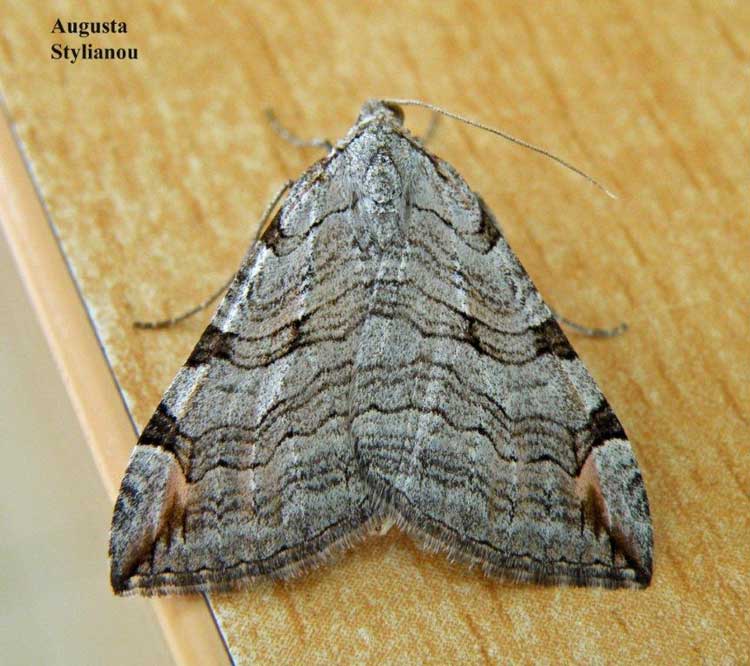
Aplocera plagiata, Germasogeia, Cyprus, Photo: Augusta Stylianou Artist
Superregnum: Eukaryota
Cladus: Unikonta
Cladus: Opisthokonta
Cladus: Holozoa
Regnum: Animalia
Subregnum: Eumetazoa
Cladus: Bilateria
Cladus: Nephrozoa
Cladus: Protostomia
Cladus: Ecdysozoa
Cladus: Panarthropoda
Phylum: Arthropoda
Subphylum: Hexapoda
Classis: Insecta
Cladus: Dicondylia
Subclassis: Pterygota
Cladus: Metapterygota
Infraclassis: Neoptera
Cladus: Eumetabola
Cladus: Endopterygota
Superordo: Panorpida
Cladus: Amphiesmenoptera
Ordo: Lepidoptera
Subordo: Glossata
Cladus: Coelolepida
Cladus: Myoglossata
Cladus: Neolepidoptera
Infraordo: Heteroneura
Cladus: Eulepidoptera
Cladus: Ditrysia
Cladus: Apoditrysia
Cladus: Obtectomera
Cladus: Macroheterocera
Superfamilia: Geometroidea
Familia: Geometridae
Subfamilia: Larentiinae
Tribus: Chesiadini
Subgenus: Aplocerina
Genus: Aplocera
Species: Aplocera plagiata
Subspecies: A. p. hausmanni – A. p. plagiata
Name
Aplocera plagiata (Linnaeus, 1758)
References
Hermosa, A. Expósito, 1998: Description of Aplocera vivesi Expósito, n. sp. and Aplocera plagiata hausmanni Expósito, n. ssp., from Spain (Lepidoptera: Geometridae). Shilap Revista de Lepidopterologia 26 (102): 95–99.
The treble-bar or St. John's wort inchworm (Aplocera plagiata) is a moth of the family Geometridae. the species was first described by Carl Linnaeus in his 1758 10th edition of Systema Naturae. It is found throughout the Palearctic region and the Near East.
This species varies considerably in size (wingspan 37–43 mm) and colouration but is generally grey with three characteristic dark fascia across each forewing, giving it its common name. The hindwings are pale grey or buff. Many forma have been described. See Prout (1912–16) [1]Aplocera plagiata is difficult to certainly distinguish from its congener Aplocera efformata See Townsend et al.[2]
One or two broods are produced each year. In the British Isles, the adults can be seen at any time from May to September. The species flies at night and is attracted to light. The egg is whitish, without gloss, micropylar rosette 11- to 12-leaved, the sides with regular polygonal reticulation, each cell again more irregularly subdivided. The larva is also very variable, being green to reddish brown with alternating darker and lighter stripes. It feeds on various species of St John's wort (Hypericum species). It overwinters as a small larva.
Moth and larrva depicted in Die Schmetterlinge Deutschlands 10,10a
Subspecies
Aplocera plagiata hausmanni
Aplocera plagiata plagiata
References
Prout, L. B. (1912–16). Geometridae. In A. Seitz (ed.) The Macrolepidoptera of the World. The Palaearctic Geometridae, 4. 479 pp. Alfred Kernen, Stuttgart.pdf
Martin C. Townsend, Jon Clifton and Brian Goodey (2010). British and Irish Moths: An Illustrated Guide to Selected Difficult Species. (covering the use of genitalia characters and other features) Butterfly Conservation.
Chinery, Michael Collins Guide to the Insects of Britain and Western Europe 1986 (Reprinted 1991)
Skinner, Bernard Colour Identification Guide to Moths of the British Isles 1984
Retrieved from "http://en.wikipedia.org/"
All text is available under the terms of the GNU Free Documentation License

